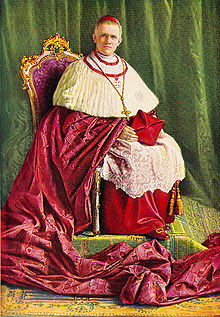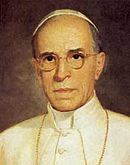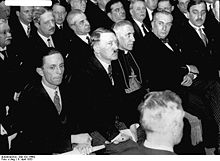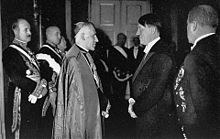- Cesare Orsenigo
-
 Orsenigo with Hitler and Joachim von Ribbentrop
Orsenigo with Hitler and Joachim von Ribbentrop
Cesare Vincenzo Orsenigo (born December 13, 1873 in Villa San Carlo, Italy, died April 1, 1946 in Eichstätt) was Apostolic Nuncio to Germany from 1930 to 1945, during the rise of Nazi Germany and World War II. Along with the German ambassador to the Vatican, Diego von Bergen and later Ernst von Weizsäcker, Orsenigo was the direct diplomatic link between Pope Pius XI and Pope Pius XII and the Nazi regime, meeting several times with Adolf Hitler directly and frequently with other high-ranking officials and diplomats.
Orsenigo was close with Achille Ratti, the Archbishop of Milan, and was appointed to the Vatican diplomatic corps when Ratti was elected Pope Pius XI, as nuncio to The Netherlands (1922-1925), Hungary (1925-1930), and Germany (1930-1945).
Orsenigo was a controversial figure among his contemporaries and remains the subject of historical criticism for his advocacy of "compromise and conciliation" with the Nazis, particularly in relation to The Holocaust.[1] Pius XII has been criticized by several contemporaries and historians for not replacing Orsenigo as nuncio. Pius XII left the nunciature vacant after Orsenigo's death in 1946 until he appointed Aloisius Joseph Muench to the post in 1951.
Styles of
Cesare Orsenigo
Reference style The Most Reverend Spoken style Your Excellency Religious style Monsignor Posthumous style none Contents
Early life and education
 Pope Pius XI, a friend of Orsenigo in Milan who appointed him to all three of his nunciatures
Pope Pius XI, a friend of Orsenigo in Milan who appointed him to all three of his nunciatures
Orsenigo was born in Olginate, Italy.[2] He attended a seminary in Milan and Kaplan and later he became a priest of San Fedele in Milan. 1912, he was finally a member of the cathedral chapter of Milan. Even as a parish priest in Milan, he met Achille Ratti, who soon after became Pope Pius XI.
Nuncio to the Netherlands (1922-1925)
Ratti, after his election as pope in 1922 appointed Orsenigo to the rank of titular archbishop of Ptolemais and made him a nuncio to the Netherlands, effective June 23, 1922.[2] Orsengio, aged 49 at his appointment, had no formal diplomatic training, but rather had been a friend of Ratti in Milan.[3] Ratti overruled Orsenigo's objections that he lacked experience, noting that he himself had spent decades as a librarian before being appointed apostolic delegate to Poland.[1]
He received the episcopal consecration on 29 June 1922 from Pietro Gasparri, who was then Camerlengo and Cardinal Secretary of State.
Nuncio to Hungary (1925-1930)
Orsenigo remained until his appointment as Apostolic Nuncio in Hungary in the summer of 1925 while at The Hague.[2]
Nuncio to Germany
 Orsenigo shaking hands with Joseph Goebbels
Orsenigo shaking hands with Joseph Goebbels
Under Pius XI (1930-1939)
On April 25, 1930, he became Apostolic Nuncio in Germany, a post previously held by Eugenio Pacelli (future Pope Pius XII), who had been appointed Cardinal.[2] He received his conformation letter from President Paul von Hindenburg. Orsenigo's nunciature was located in Berlin, although a separate nunciature existed in Munich due to its "peculiar status" dating back to 1871.[4]
On February 16, 1933, Orsenigo wrote to Pius XII that it would be "ingenuous and incoherent" to support the newly elected Nazi government, but that he feared open opposition would lead to a new Kulturkampf.[1] In a March 7, 1933 letter to Pius XII, Orsenigo estimated that six to seven million of Germany's thirteen million voting Catholics had supported the Nazi party.[1] According to George Schuster, Orsenigo "was frankly jubilant" over the election of Hitler.[5] As early as March 1933, Orsenigo concluded that "compromise and conciliation" was the only option, arguing that earlier condemnations of Nazism by German bishops had concerned only its religious, not political, tenets.[1]
After the conclusion of the Reichskonkordat on July 20, 1933, Orsenigo urged German bishops to support the Nazi regime.[6] For example, anti-Nazi bishop Kaller Ermland complained that Orsenigo (who, Ermland assumed, spoke for the pope) "put the skids under me" by telling him to make amends with the Nazis.[6] Orsengio punished Bishop August von Galen, who continued to publicly criticize the Nazi's euthanasia program, with a critical letter to Rome.[6]
Writing on May 8, 1933 about an earlier conversation with Hitler, Orsenigo opined that Hitler saw Christianity as essential to private life and the German state and that without the cooperation of the Nazis the German church could not hope to defeat liberalism, socialism, and Bolshevism.[7] Orsenigo reported that Hitler did not agree with the neo-pagan wing of the Nazi party, as represented in Alfred Rosenberg's The Myth of the Twentieth Century.[7]
Following an April 4, 1933 transmission from Pope Pius XI to "look into whether and how it might be possible to become involved" in helping the victims of Nazi persecution, Orsenigo replied that any intervention would be seen as "a protest against that government's law" and thus not be advisable.[8] Of the 95 documents from the Berlin nunciature in the Vatican Secret Archives from 1930 to 1938, only four contain references to Jews.[9]
Under Pius XII (1939-1945)
Pius XII retained Orsenigo as nuncio to Germany; his priorities (as he made clear to Orsenigo) were the preservation of the Reichskonkordat specifically, and Vatican-German relations more generally.[10] According to Phayer, "In Orsenigo, Pius had the right man for the job. A pro-German, pro-Nazi, antisemitic fascist, Orsenigo would have no trouble adjusting to the Nazi regime in Berlin. In addition, Orsenigo who hankered after the cardinal's hat, could be trusted not to interfere with Pius's well-known intention to deal with Germany himself".[10] On the orders of Pius XII, Orsenigo warmly and publicly congratulated Hitler on April 20, 1939, the Führer's fiftieth birthday.[6]
On May 4, 1939, Orsenigo visited Adolf Hitler in Obersalzberg; Orsenigo was flown to Salzberg and had lunch at the Grand Hotel in Berchtesgaden before being transported to Hitler's residence, where the two spoke privately for an hour before having tea with von Ribbentrop and his aide V. Hewel (who also wrote an account of the meeting).[11] In a 1940 note to Pius XII, Orsenigo again argued in favor of conciliation, stating his fears of lapsed religiosity among German Catholics "unless the clergy appeased the regime and relieved members of the church of a conflict of conscience".[12]
On June 21, 1942, he was a consecrator at the Cologne Cathedral for the inauguration of the new archbishop in Cologne, Joseph Frings. In November 1943, he again met with Hitler on behalf of Pius XII. According to Orsenigo's own account:
- "As soon as I touched upon the question of Jews and Judaism, the serenity of the meeting ended at once. Hitler turned his back to me, went to the window and started drumming his fingers on the pane [...] Still, I went on, voicing our complaints. Hitler suddenly turned around, went to a small table from which he took a water glass and furiously smashed it on the floor. In the face of such diplomatic behavior, I had to consider my mission terminated".[13]
On February 8, 1945, prior to the end of World War II, Orsenigo moved to Eichstätt, in Bavaria.[4] The nunciature lost its official status in May 1945, with the defeat of Nazi Germany, although the Allied Control Council allowed Orsenigo to remain in Eichstätt.[4] Orsenigo died in Eichstätt on April 1, 1946, leaving his aide de camp, Monsignor Carlo Colli as the only remaining link between Pius XII and the German Church.[4] Colli died in January 1947, leaving his secretary Monsignor Bernard Hack alone in Eichstätt.[4] After a lengthy interregnum, during which Pius XII relied on Father Igo Ziegler at the Villa Grosch in Kronberg, the next nuncio would be Aloisius Joseph Muench.[14]
The Holocaust
 Kurt Gerstein, whom Orsenigo refused to meet
Kurt Gerstein, whom Orsenigo refused to meet
Orsenigo as nuncio routinely refused to intervene on behalf of Jews and more often than not failed to forward to Rome reports descriptive or critical of the Holocaust.[6] A rare exception, was the Nazi plan to "resettle" Jews married to Christians, although Phayer argues that his concern was primarily with their Catholic spouses.[6] According to Phayer, "when the nuncio was directed by the Holy See to discuss incidents concerning Jewish victims with Nazi officials, he did so timidly and with embarrassment".[6]
In 1941, Orsenigo was contacted by Kurt Gerstein, a Protestant SS officer who had personally witnessed the extermination of Jews and wished to notify the Vatican.[15] Informed of the purpose of Gerstein's visit, Orenigo refused to meet with him.[15] Gerstein's message was eventually sent to the Vatican, by the auxiliary bishop of Berlin, not the nuncio's office, where the information reached a "dead end".[15]
- The Netherlands
Both the Catholic and Protestant Churches of The Netherlands were vocal in their protests against the deportation of the Dutch Jewry, although the mainline Protestant Church eventually turned silent on the basis of Nazi promises that doing such would save further "Jews" of their denomination from deportation.[16] Orsenigo sent word to the Vatican that the protest of the Church had caused the Dutch deportations to end, despite the fact that exactly the opposite had occurred, and seizures, murders, and deportations of Catholics of Jewish heritage increased.[16]
- Poland
Because Germany would not allow Pius XII to appoint a nuncio to occupied Poland, Orsenigo fulfilled that role as well, for all intents and purposes.[17] On November 1, 1939, Orsenigo's authority was formally extended to Poland.[18] In August 1940, Orsenigo indeed launched a private protest with the German government, listing a variety of abuses against the Polish church (but none against the Polish people); this had no noticeable effect.[17] Bishop Adam Stefan Sapieha of Cracow wrote Orsenigo, telling him that a direct protest by the pope (rather than the nuncio) was "indispensable".[17] Phayer finds it "doubtful" that Orsenigo forwarded Sapieha's request to the Holy See.[19]
Among Polish Catholics, there was a widespread perception that Orsenigo "purposefully minimized their situation in his reports to Rome".[19] For example, Hilarius Breitinger, the apostolic administrator of Warthegau, delivered two copies of a letter critical of the pope's silence towards Berlin with regard to the situation in Poland: one to Orsenigo and another to Cardinal Michael von Faulhaber, only the latter of whom assured Breitinger they would deliver the letter.[19]
A November 25, 1939 dispatch from Orsenigo prompted Pius XII to make "one of his most controversial decisions".[20] Orsenigo informed the pope of the situation in the Diocese of Chełmno-Pelpin: the bishop, Stanisław Wojciech Okoniewski, was in exile; his auxiliary was ill; all but one canon was absent; only 20 of the 500 priests of the diocese had not been forced out, imprisoned, or murdered.[20] Pius XII therefore reversed his decision not to replace Polish prelates with (even temporary) German ones, naming Karl Maria Splett, the bishop of Danzig, also apostolic administrator of Chełmno-Pelpin.[20] This decision was seen as a betrayal by the Polish government-in-exile, as the Concordat of 1925 prohibited placing any Polish territory under the jurisdiction of a bishop outside Poland.[20]
German espionage
The RSHA infiltrated the Berlin nunciature through a German journalist who was to Orsenigo and a through a patriotic German priest who served under Orsenigo as adviser on German and east European affairs.[21] According to Alvarez and Graham, this espionage provide "access to the attitudes and intentions of the nuncio".[21]
Orsenigo's primary priest-assistant was in fact a secret member of the Nazi party.[6] It is unknown whether Orsenigo himself was aware of his assistants party membership, however this fact was certainly known by Robert Leiber, a German Jesuit who served as one of Pius XII's closest confidants and advisers during the war.[22]
Legacy
 Cardinal Theodor Innitzer was among the contemporary critics of Orsenigo.
Cardinal Theodor Innitzer was among the contemporary critics of Orsenigo.
According to Prof. Jose Sánchez, "a chief point of criticism of [Pope Pius XII] is his unwillingness to replace Cesare Orsenigo as his nuncio to Berlin".[23] The Vatican received many contemporary complains about Orsenigo as nuncio; for example, Cardinal Theodor Innitzer, the Archbishop of Vienna, wrote to Cardinal Secretary of State Luigi Maglione in 1939, stating that Orsenigo was too timid and ineffectual.[24] The German episcopate was divided on Orsenigo; Bishop Konrad von Preysing wrote a letter to the Vatican in 1937 calling Orsenigo too sympathetic with the Nazis, but Cardinal Adolf Bertram, the chairman of the German Bishops Conference, wrote a letter of praise recommending that Orsenigo be allowed to stay.[25] von Preysing had a history of correspondence with Orsenigo, but became frustrated upon receiving the following response: "charity is well and good but the greatest charity is not to make problems for the church".[26]
Owen Chadwick argues that "the Pope knew how weak with the Nazis [Orsenigo] was".[23] Phayer and Morley also criticize Pius XII for leaving Orsenigo at one of his most important nunciatures.[23] However, Pierre Blet argues that had Orsenigo been replaced, a new nuncio may not have been accepted by the Nazis and the Vatican would have lost communication with the German church.[23]
Susan Zuccotti argues that Orsenigo was "never known for his imagination or daring".[27] Chadwick states that "Orsenigo saw nothing but ill to come from a breach between the Church and a Nazi State. As an Italian he believed in the Fascist State. His ideas on what ought to happen in Germany were formed on the basis of what happened in Italy".[28] Chadwick credits to Orsenigo the creation of a chaplain-general for the German army, the circulation of pastoral letters from German bishops on pro-Nazi subjects such as mass procreation.[28]
Notes
- ^ a b c d e Goldman, 2004, p. 31.
- ^ a b c d Brown-Fleming, 2006, p. 180, note 68.
- ^ Goldman, 2004, p. 30.
- ^ a b c d e Brown-Fleming, 2006, p. 35.
- ^ Lewy, 1964, p. 27.
- ^ a b c d e f g h Phayer, 2000, p. 45.
- ^ a b Godman, 2004, p. 32.
- ^ Godman, 2004, p. 33.
- ^ O'Shea, 2008, p. 232.
- ^ a b Phayer, 2000, p. 44.
- ^ Cornwell, 1999, p. 224.
- ^ Sánchez, 2002, p. 101.
- ^ Kurzman, 2007, p. 125.
- ^ Brown-Fleming, 2006, p. 36.
- ^ a b c Phayer, 2000, p. 46.
- ^ a b Phayer, 2008, p. 59.
- ^ a b c Phayer, 2008, p. 28.
- ^ Blet and Johnson, 1999, p. 72.
- ^ a b c Phayer, 2008, p. 29.
- ^ a b c d Blet and Johnson, 1999, pp. 72-73.
- ^ a b Alvarez and Graham, 1997, p. 10.
- ^ Phayer, 2000, p. 260.
- ^ a b c d Sánchez, 2002, p. 168.
- ^ O'Shea, 2008, p. 234.
- ^ Reinhold, H.A. 1996. "H. A. REINHOLD: LITURGICAL PIONEER AND ANTI-FASCIST". Catholic Historical Review, 82(3).
- ^ Phayer, 2000, p. 78.
- ^ Zuccotti, 2000, p. 74.
- ^ a b Chadwick, 1995, p. 21.
References
- Alvarez, David J., and Graham, Robert A. 1997. Nothing sacred.
- Blet, Pierre, and Johnson, Lawrence J. 1999. Pius XII and the Second World War: According to the Archives of the Vatican. Paulist Press. ISBN 0809105039.
- Brown-Fleming, Suzanne. 2006. The Holocaust and Catholic Conscience: Cardinal Aloisius Muench and the Guilt Question in Germany. University of Notre Dame Press. ISBN 0-268-02187-2.
- Chadwick, Owen. 1988. Britain and the Vatican During the Second World War.
- Cornwell, John. 1999. Hitler's Pope: The Secret History of Pius XII. Viking. ISBN 0-670-87620-8.
- Godman, Peter. 2004. Hitler and the Vatican: Inside the Secret Archives That Reveal the New Story of the Nazis and the Church. ISBN 0743245970.
- Kurzman, Dan. 2007. A special mission. Da Capo Press. ISBN 0306814684.
- Lewy, Guenter. 1964. The Catholic Church and Nazi Germany. New York: McGraw-Hill. ISBN 0-306-80931-1
- O'Shea, Paul. 2008. A Cross Too Heavy.
- Phayer, Michael. 2000. The Catholic Church and the Holocaust, 1930–1965. Indianapolis: Indiana University Press. ISBN 0-253-33725-9.
- Phayer, Michael. 2008. Pius XII, The Holocaust, and the Cold War. Indianapolis: Indiana University Press. ISBN 978-0-253-34930-9.
- Sánchez, José M. 2002. Pius XII and the Holocaust: Understanding the Controversy. Washington D.C.: Catholic University of America Press. ISBN 0-8132-1081-X
- Zuccotti, Susan. 2000. Under his very Windows, The Vatican and the Holocaust in Italy. New Haven and London: Yale University Press. ISBN 0-300-08487-0
External links
- Cesare Orsenigo in the hierarchy of the Catholic Church
- Preview of a scientific edition of Orsenigo's reports from his mission to Germany
Catholic Church titles Preceded by
Giovanni Tacci Porcelli
as internuncioNuncio to The Netherlands
1922 – 1925Succeeded by
Paolo GiobbePreceded by
noneNuncio to Hungary
1925 – 1930Succeeded by
Angelo RottaPreceded by
Eugenio PacelliNuncio to Germany
1930 – 1945Succeeded by
Aloisius Joseph MuenchPope Pius XII (1939–1958) Biography Early life · Nunciature · US visit · Election · Late years · Illness and death · Testament · Cause for Canonization
World War II The Holocaust (statements on) (conversion of Jews during) · Roman razzia · Occupied dioceses · Ustaše involvement · Jewish orphans · Pontifical Relief Commission · 1942 Christmas address · Alleged kidnapping plot · Yad Vashem · Bombing of RomeForeign relations Nazi Germany (Reichskonkordat) · Post-World War II · "Ratlines" · Persecutions · China · Eastern Europe · Poland · RussiaTheology Social teachings · Mariology · Judaism · Liturgy · Eastern Canon Law · Canonizations · Beatifications · Fátima and BalasarWritings Appointments Advisers Bibliography Pope Portal  Catholicism PortalCategories:
Catholicism PortalCategories:- Diplomats of the Holy See
- Roman Catholic titular archbishops
- Pope Pius XII appointments
- 1873 births
- 1946 deaths
Wikimedia Foundation. 2010.


